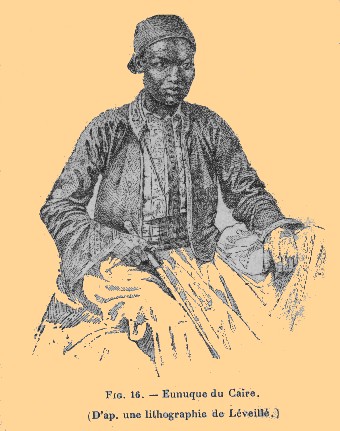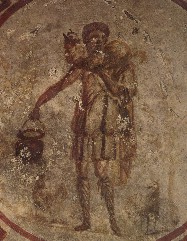
![]()

"Born Eunuchs" Home Page and Library
Almost all people by nature are able to respond sexually to both sexes, although most people choose, or are conditioned, to limit themselves to the opposite sex. Thus, for almost all so-called "straight" people, their sexual identity is defined by their behavior, and is subject to influence or change. In fact, in the ancient world, most people were involved with both sexes at different times in their lives.
However, as a minority, gays differ by nature from the majority -- not in our attraction to the same sex, but only in our physical lack of response to the opposite sex. Being naturally impotent for procreative sex, innately gay men were referred to in the ancient world as "born eunuchs" or just "eunuchs." Meanwhile, women who innately lacked response to men were seen as a particular kind of "virgins."
ARTICLES:

The willingness to engage in homosexual activity (particularly intergenerationally) was widespread among men in the ancient Mediterranean region. Women and boys were considered equally tempting sex objects for ordinary men. Therefore, homosexual activity could not have provided a means of distinguishing a minority of men as "gay" the way we do in the modern world. However, the ancients did differentiate based on an unwillingness or incapacity for heterosexual sex. Certain men were known to fundamentally lack arousal for sex with women, and men of this kind were distinguished from the majority of ordinary men on that basis. The innately and exclusively homosexual men of the ancient world inhabited the category of eunuchs. What we moderns think of as eunuchs, namely castrated men, were simply a limited subset of the category, referred to at the time as "man-made eunuchs." Incredible as it sounds today, society in the past valued gay men so much for their inherent qualities that the market used to try (without success) to manufacture them!
Natural and man-made eunuchs co-existed as distinct categories for at least a thousand years, from the first-reported mass castrations about 600 BCE until 400 CE, when the classification of "natural eunuchs" was essentially made obsolete, and only the artificial type were identified as eunuchs anymore. At that time Catholic Church leaders began using their new influence over Roman imperial law to recategorize natural eunuchs as males in order to prosecute them as criminal perpetrators of sodomy against their own bodies.
What was called sodomy in the Judeo-Christian tradition, namely the sexual penetration of "males," was criminalized in many ancient cultures. But it had never before been associated in law with sex between exclusively homosexual men, or with sex practised on homosexual men in the passive role by straight men in the active role. Exclusively homosexual men did not meet the definition of "male," because maleness or virility meant the aptitude to play the male role in procreative sex, which they lacked by nature. It had always been decent and respectable for an ordinary man, playing the insertive role, to have sex with an exclusively homosexual man (i.e. a non-male eunuch) as a passive partner, which is why so many Roman emperors had their eunuch lovers. Penetrating an exclusively homosexual man had not been considered a crime before -- the crime was penetration of a potentially heterosexual man, which was sometimes committed for the purpose of profoundly humiliating an adversary or helpless victim. Therefore, sodomy was a crime committed against non-gay men, and mostly by non-gay men.
The reason why some people now accuse exclusively homosexual men of being sodomites is that, over time, the ancient, even primeval distinction between types of men, based on the presence or absence of heterosexual arousal in them, has been deliberately erased by patriarchal religious leaders. This erasure actually began with the emergence of rational scientific philosophy, but reached a critical turning point in the writings of the "fathers of the church", who were claiming to emulate a heterosexually abstinent role model, Jesus, at a time when absolute abstinence from heterosexuality traditionally implied queerness as well as spiritual holiness. In order to lay claim to the holiness of abstinence while escaping the queerness of it, church leaders declared the greater virtue of their strong, manly abstinence based on will power as opposed to the abstinence of holy eunuchs based on their natural inclination. Since even willed abstinence from heterosexuality laid church leaders open to the social shame of being called eunuchs and non-males, they used their influence to promote the view of maleness as an anatomical characteristic alone, and they restricted the meaning of the term "eunuchs", whether born so or man-made, to those who lacked reproductive organs. Once redefined as males, exclusive, innate homosexuals became fair game for prosecution as sodomites, because they were subjecting their "male bodies" to sexual penetration.